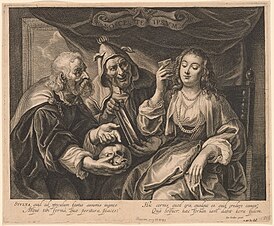Vanity

Vanityis the excessive belief in one's own abilities or attractiveness to others. Prior to the 14th century, it did not have suchnarcissisticundertones, and merely meantfutility.[1]The related termvaingloryis now often seen as an archaic synonym forvanity,but originally meantconsidering one's own capabilities and that God's help was not needed,i.e. unjustifiedboasting;[2]althoughgloryis now seen as having a predominantly positive meaning,[citation needed]theLatinterm from which it derives,gloria,roughly meansboasting,and was often used as a negative criticism.[3]
Religion and philosophy
[edit]In many religions, vanity, in its modern sense, is considered a form of self-idolatryin which one likens oneself to the greatness of God for the sake of one's own image, and thereby becomes separated and perhaps in time divorced from the Divine grace ofGod.In Christian teachings,vanityis an example ofpride,one of theseven deadly sins.Also, in theBaháʼí Faith,Baha'u'llahuses the term 'vain imaginings'.[4]
Philosophically, vanity may be a broader form ofegotismandpride.Friedrich Nietzschewrote that "vanity is the fear of appearing original: it is thus a lack of pride, but not necessarily a lack of originality."[5]One ofMason Cooley'saphorismsis "Vanity well fed is benevolent. Vanity hungry is spiteful."[5]
Symbolism
[edit]
In Western art, vanity was often symbolized by apeacock,and inBiblicalterms, by theWhore of Babylon.During theRenaissance,vanity was often represented as a naked woman, sometimes seated or reclining on a couch. She attends to her hair with comb and mirror. The mirror is sometimes held by ademonor aputto.Symbols of vanity include jewels, gold coins, a purse, and the figure of death.[citation needed]
Some depictions of vanity include scrolls that readOmnia Vanitas( "All is Vanity” ), a quotation from the Latin translation of the Biblical book ofEcclesiastes.[6]Although the termvanitas(Latin, "emptiness" ) originally meant not obsession by one's appearance, but the ultimate fruitlessness of humankind's efforts in this world, the phrase summarizes the complete preoccupation of the subject of the picture.
"The artist invites us to pay lip-service to condemning her," writesEdwin Mullins,"while offering us full permission to drool over her. She admires herself in the glass, while we treat the picture that purports to incriminate her as another kind of glass—a window—through which we peer and secretly desire her."[7]The theme of the recumbent woman often merged artistically with the non-allegorical one of a recliningVenus.

In his table of theseven deadly sins,Hieronymus Boschdepicts abourgeoiswoman admiring herself in a mirror held up by a devil; behind her is an open jewelry box. A painting attributed toNicolas Tournier,which hangs in theAshmolean Museum,isAn Allegory of Justice and Vanity:a young woman holds abalance,symbolizingjustice;she does not look in a mirror or theskullon the table before her.Johannes Vermeer's paintingGirl with a Pearl Earringis sometimes believed to depict the sin of vanity, because the young girl has adorned herself before a glass without further positive allegorical attributes.
All is Vanity,byCharles Allan Gilbert(1873–1929), carries on this theme. Anoptical illusion,the painting depicts what appears to be a large grinning skull. Upon closer examination, it reveals itself to be a young woman gazing at her reflection in the mirror. In the 1997 filmThe Devil's Advocate,Satan(Al Pacino) claims that "vanity is his favourite sin".
Such artistic works served to warn viewers of the ephemeral nature of youthful beauty, as well as the brevity of human life and the inevitability of death.
See also
[edit]Further reading
[edit]- Bossuet, Jacques-Bénigne(1900)..The Sermon on the Mount.Longmans, Green, and Co.
References
[edit]- ^Oxford English Dictionary,onvanity
- ^Oxford English Dictionary,onvainglory
- ^Oxford English Dictionary,onglory
- ^"Vain Imaginings".Bahai Quotes.Archived fromthe originalon 2016-04-07.Retrieved2023-03-28.
- ^abBartlebyArchived2006-03-01 at theWayback Machine
- ^James Hall,Dictionary of Subjects & Symbols in Art(New York: Harper & Row, 1974), p. 318.
- ^Edwin Mullins,The Painted Witch: How Western Artists Have Viewed the Sexuality of Women(New York: Carroll & Graf Publishers, Inc., 1985), pp. 62–63.
- ^"Daydreams".The Walters Art Museum.
